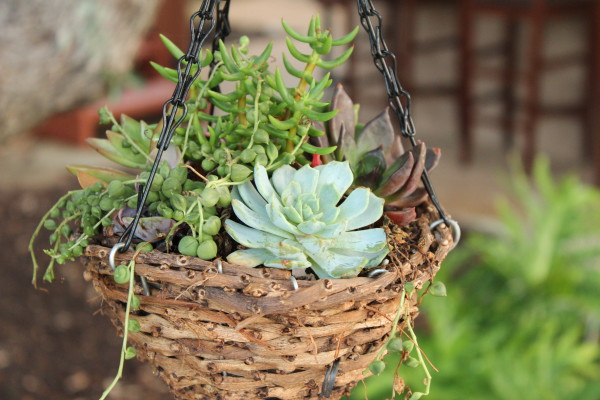

By now, gardeners are busily planning and planting — trying to get their gardens established before the heat of summer strikes. Our current Central Texas drought status remains an alarming D2 (severe) to D4 (exceptional — the worst category). So Central Texans are still looking for ways to make their landscapes more xeric, eliminate more lawn, and reduce their water usage. By August, even watering potted plants every single day starts to get old.
Some of the most drought tolerant plants available to help us achieve those goals are succulent plants. Succulents are plants that store water in their leaves, stems and/or roots and can tolerate extreme drought and heat. They generally have few insect pests or problems with disease. Many also retain water by transpiration with their waxy leaves or stringy hairs. As an added bonus, they also do well in poor soil.
Succulents are also ideal for gardeners with limited space and limited time. They are easy-care free plants requiring almost no maintenance.
Their thick, juicy stems add interesting structure, texture, variety and color to a landscape. Beware, though, they are also delicious and juicy appetizers for deer.
Not all succulents like full sun. Many of them actually prefer partial shade with bright, but not direct sunlight.
According to Casey Limerick, of East Austin Succulents, “the biggest mistakes people make with succulents is giving them too much water and too much sun.”
While succulents are low maintenance, they are prone to rot if overwatered, a common occurrence when gardeners water them on the same schedule as their other plants.
The correct soil is important, too. “We make our own soil blend here,” said Limerick.
Limerick recommends planting succulents in a fast-draining soil mixed with a little bit of sand (not much) and a little decomposed granite.
More than 50 plant families are considered succulents. Agaves, aloes, euphorbias, sedums and yuccas are just a few of the categories of succulents.
Not all agaves turn into 6-foot-tall monsters that want to eat your entire landscape and spread their pups. There are many much smaller and manageable species that can be used as structural focal points in the landscape and beautiful potted plant arrangements. Some of the smaller agaves suitable for small gardens and containers that do well here include the squid agave, quadricolor agave, Parry’s agave and the regal Queen Victoria agave.
Yuccas are part of the genus of succulent plants and are also within the Agavacea family. While some yuccas may not look particularly succulent, their blooms look like supersized versions of smaller succulents and are often a delicious and juicy appetizer for deer.
Aloes have long been a popular succulent used as houseplants or outdoors. They also have medicinal uses and can relieve burns, treat many skin conditions, reduce bruises and be used in juices to treat indigestion.
Delosperma, also known as ice plant, makes an excellent groundcover and can survive both our heat and our average winters. It is hardy from USDA zones 5-11. It is perfect for xeriscaping and rock gardens or paths.
The euphorbia family includes a range of plants, including poinsettias and cacti. Their milky sap can irritate skin and eyes, and should be planted away from areas used by children and pets. One of the most popular varieties is euphorbia rigida, also called gopher plant, which grows to about 2 feet tall and has vivid yellow blooms in the spring.
Sedum, sempervivum and echeveria are all in the same family. Their starry clusters of flowers come in array of colors, ranging from red to pink, yellow and white. One of the most common sedums is Autumn Joy, which has a more upright growth habit.
Many gardeners will remember their mother or grandmother growing Hen and Chicks — These interesting and hardy plants come in a variety of colors ranging from pink, red, purple and green. They form a rosette (hen) that produces new offsets (chicks) and these clumps will spread and create a low growing and dense groundcover. Interestingly, they are often planted in strawberry pots.
Diana Kirby is a local Landscape Designer and Garden Coach and can be reached at http:/www.dianasdesignsaustin.com. She writes a garden blog at https://www.dianasdesignsaustin.com.

